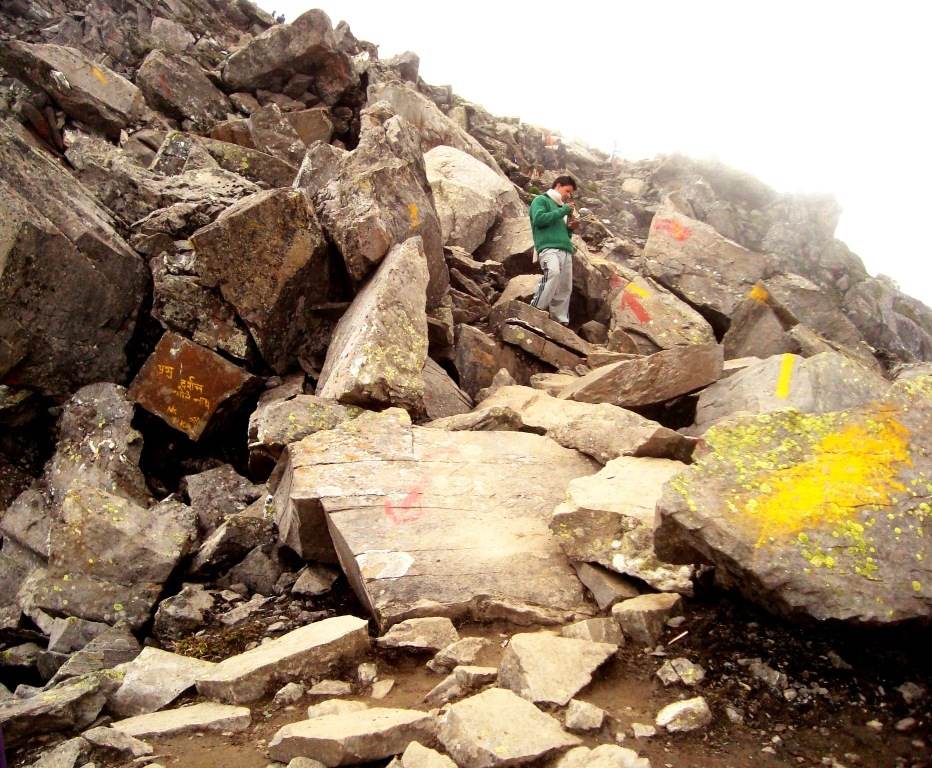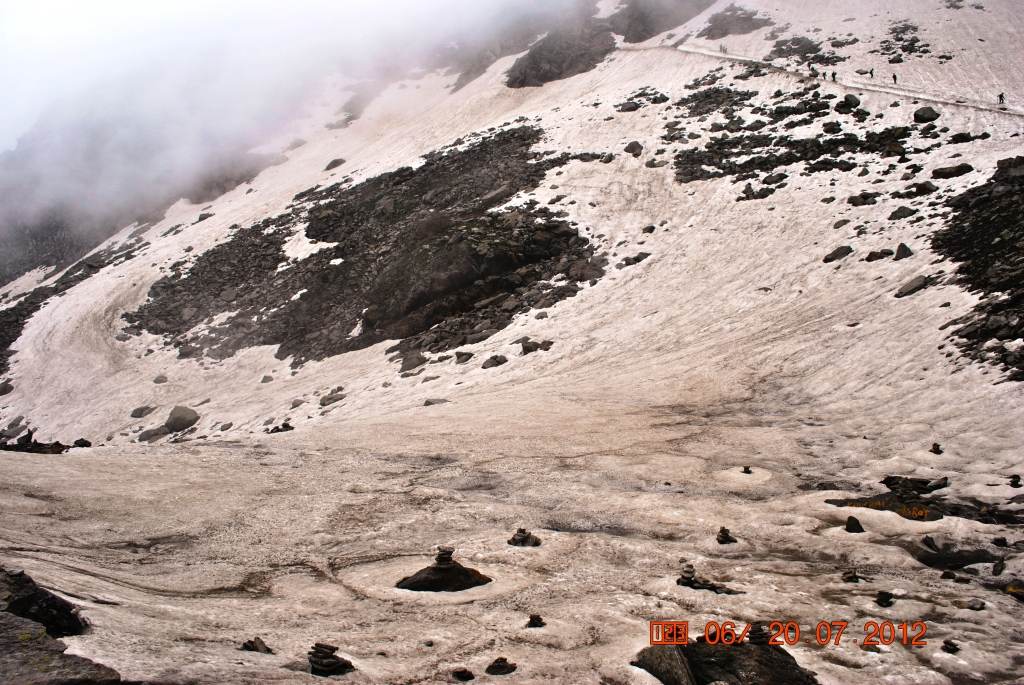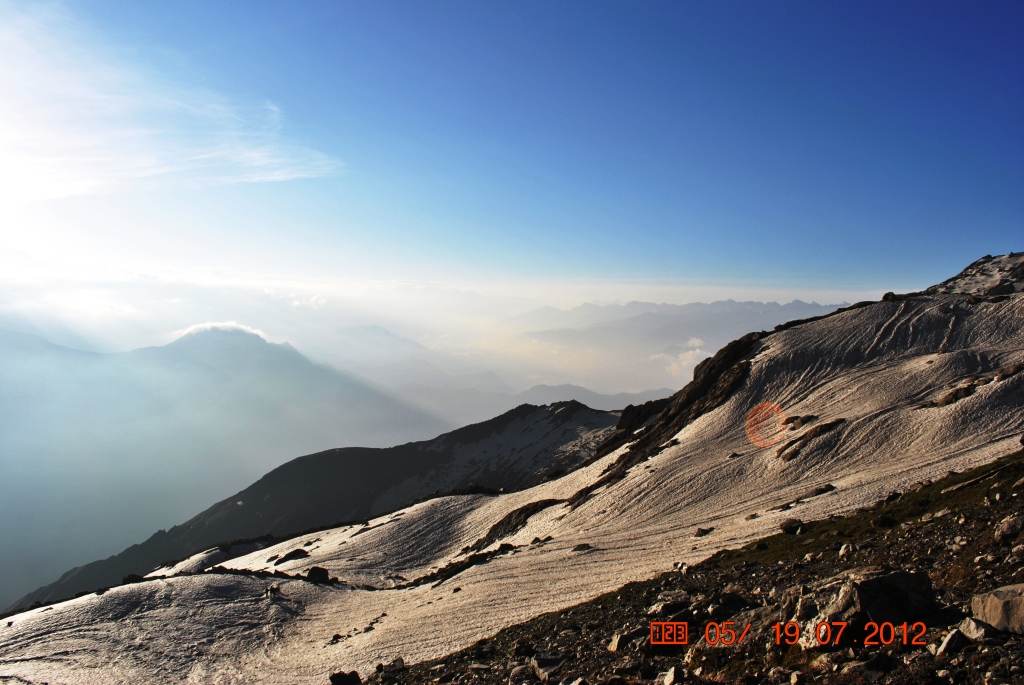Contd. from Pilgrimage to Shrikhand Mahadev Kailash Part -2
19 July and 20 July, 2012
The decision to take a different route through Bagipul was the best that we could do to help my brother who had turned grayish and was not in a position to take his body weight forward. I tried encouraging him to walk down as I knew that the earlier we reach some comfortable altitude, he would feel much better. As he, too, knew that walking was the only way to live so he, very valiantly, started the downward trek. It was about 12 O’clock when we finally decided to walk down.
We had decided to take the Bagipul route. The sketch of the Phancha route is based on my estimation of the distance. I have drawn it for the benefit of those who might take Phancha route. I looked at the glaciers towards Phancha side and silently thanked all the experiences that it had enriched me with. I thought of four pilgrims that I had met on way back through Phancha route and remembered looking at a string of white flowers that adorned their necks. Shaunka Ram had told us that when you come back from paying obeisance at Shrikhand, the people at Majbaun, the night halting shelter, give you prasad to take home and put a string of specially made flower string in your neck as a symbol of successfully accomplished the yatra. We thought how we would miss those strings as we would not be taking the same route. I had not even taken a picture of those strings as I was certain of getting one on our return journey!
The glaciers were still silently watching us when we bade good bye to them and started for the different route. There were so many pilgrims, coming up and going down, on this route. We felt safe. A young boy, attired in orange Tee, with a benign smile on his face extended his hand to support me during a difficult point. My being an elderly woman would make people help me. As all that was in my mind was how my brother would walk down carrying a backpack, I said politely, “I can take care of myself but my brother is in bad shape and I am worried about him.” He looked behind me at my brother and said, “Aunty, don’t you worry. I would walk him down till Nayan Sarovar.”
And he got hold of my brother’s hand. He asked someone to carry my brother’s backpack and asked another one to accompany me. Nayan Sarovar is 6-7 Kms and the path seemed quite good as we had seen the worst path. There were some patches of glaciers on the way and big boulders constituted most of the path.
There were big stones in the way between Nain Sarovar and Shrikhand Mahadev. It is believed that Bhim was making the stairs to heaven and these are the stones that have tumbled down to this place. The red and yellow paint signs on these stones were the only indication of the path to be followed. Sometimes a stone might come tumbling down if it lost its balance. This small portion was to be walked upon carefully.
There was a glacier near Nayan Sarowar where I preferred to glide down instead of walking. My clothes got terribly wet as the ice on this glacier had turned into wet pools at places because of heavy traffic. I thought of the virgin glaciers on the other trek which were untouched and so hard! This path seemed like a cakewalk in comparison.
We reached Nayan Sarowar and in some time I saw my brother, along with his new found guarding angel, coming down the hill. I heaved a sigh of relief. We rested for a while at Nayan Sarowar and resumed downward journey. The friendly group had provided so much of support to us. My brother, by now, was much better with the red tinge back on his face. I was relieved. Vikas, his guardian angel, who had safely walked him down to Nayan Sarovar was walking barefoot. His slim body and steely resolve endeared him to all of us.
We walked further. Relieved and light hearted distance seemed not to matter to us. Parvati Baag was barely 3 kms from Nayan Sarovar and the path was good. We could see the colorful tents at Parvati Baag.
We walked faster. When we reached the tents, we met the same group of college students who were with us during the Phancha route. Human mind is incredible. We had not had a cup of tea since we had tea at Phanchkanda the previous day at 7: 30 a.m. and neither had we craved for the same since last thirty three hours. But a look at the tents and the feeling that tea would be available made me crave for a hot steaming cup of tea! Putting our luggage outside we went inside a tent and sat before a kerosene stove on which we could see an Aloo parantha simmering lightly on a tawa! Suddenly the salivary glands in our mouth activated to their fullest and my brother ordered paranthas for us. I preferred to take only a cup of tea. But we orders two cups of tea for each of us as we wanted to have it to our fill.
There is warning sign for the pilgrims going upwards not to proceed after 3 p.m. from Parvati Baag as you have to return to Parvati Baag for the night stay. There is no provision of any kind of staying arrangement beyond this point. It takes about 5-6 hours from this point to reach Shrikhand so you must plan accordingly so that you reach back in time.
Parvati Baag has many tents and one can easily find a resting place for the night. We were tired. There was a choice to be made—either to stay at Parvati Baag or to walk still further to Bheem Dwar, 4 km from there. As it was not yet dark and as we wanted to cover as much distance as we could till we fell flat to call it a day, we decided to walk. Now we could see a lot many tents in the distance at Bheem Dwar. Though the place seemed close at hand and also as we were now descending down, we thought that we would reach early. I learnt that walking down was much tougher and when we finally reached Bheem Dwar we were dead tired. But the aroma of food being served in the Langar took away all the tiredness from our bodies. My brother and his friend went to make an arrangement for night stay whereas I dashed straight for the tea canter where from you could take as much of tea as you could drink! The masala tea was hot, syrupy and sweet. I enjoyed sipping it silently.
I decided to have dinner as well and then finally go to the tent to sleep. So I fetched a thali and got serving of rice, daal and kadhi. I had decided to take another cup of tea before going to the tent. But when I had finished my dinner and went to have another cup of tea, the tea-time was over and there was no tea. Disappointed, I came back. Suddenly someone called me, “Arre, you, too, have come?” I looked back and found a familiar face asking me this question. “We have organized this langar” he said. It was a pleasant surprise for me to find that Tarsem Ji from Hamirpur was the man behind organizing this Langar. We were taken inside. We had a hearty chat with Tarsem Ji and also we were offered tea!
Looking back at all these small wishes of mine being taken care of, unexpectedly, I can see for sure that this was the way of Shiva to show how He is there taking care of us. We came back to the small tent. It was so small that three of us just barely cramped inside. There were sleeping bags and we could not even move any limb in any direction but somehow the night passed and soon it was morning. There were lot many voices outside—some pilgrims were on way to Shrikhand and many were on way to Bagipul.
We hurriedly got up and got ready for the downward journey. We had planned to walk to Jaon village, from where we could get some transportation, by evening. It was a long distance of 23 km. We were quite fresh and decided to have a cup of tea on way instead of waiting for tea at Bheem Dwar.
Some distance from Bheem Dwar was Beem Talai and the colorful tents in the green background under the clear blue sky seemed so beautiful. We reached Bheem Talai in some time but as it would have taken some time for the tent wallah to prepare tea for us, we preferred to walk on.
Next stoppage was Kunsha, another picturesque place. Here we rested a while in a tent which was now empty with its occupants left. I looked around. All that I could see were the telltale signs of spitting in and around the tent. I wondered how could someone spit so much? Don’t people have any civic sense?
We walked further and now the next stop was Kali Ghati. But what a stretch of difficult terrain it was! Till now we had been walking quite comfortably but now the steep ascent to reach Kali Ghati was too much for our tired soles and souls!
There was a small water bowli on the way which had such clear water the kind of which I had not seen. From this bowli we ascended further. The trek was extremely tough at this point. Somehow we reached Kali Ghati.
This is 12000 feet high from sea level. There were red flags fluttering in morning air before the idol of Kaali Jogini at Kali Ghati. We paid our obeisance to her for having completed the Yatra. This is the spot where pilgrims on way to Shrikhand pay obeisance to Kali Jogini and seek her blessings.
We had another cup of tea at Kali Ghati and moved further. We had decided to reach Thachru for lunch. It was still much away and the path was narrow and slippery as it had rained the previous night. There were very strange trees on the way that lay almost horizontally on the path instead of growing vertical. The path was slippery but the branches of these trees provided much needed walking support to us.
The sky had become overcast with clouds. It was dark during the morning time. We were sure that we would be drenched in rain if we won’t reach Thachru. We reached Thachru before it started to rain. Once again I was surprised when an acquaintance from Hamirpur walked to me with a welcoming smile. We had the most sumptuous meal at the langar. We were asked to rest in a spacious tent and met very wonderful people there. We were served hot, tasty tea which we needed so much. As it was raining heavily so we rested for some time.
We resumed our journey only when it had stopped raining. We stopped for tea in a tent as it had again started drizzling and resumed walking in a short while. But now the almost vertical descent had become very slippery and treacherous. It was difficult to hold your foot as the ground was much slippery. I realized that walking downhill was more difficult than walking uphill. The whole path was full of people—going upward and going downward. The pilgrims coming up would ask us, “how far is Shrikhand?” And we would say, “Keep going, not much far!”
And so far we were concerned, we were tired, dead tired but the feeling that it would be over very soon made us go on and on! We could see the sound of the water in the rivulet down and as the sound kept on increasing in intensity so was our hope that we were near to it!
We reached the rivulet. It was the last leg of the journey. We crossed it and then passed some big boulders jumping from one to another and reached the bank of the rivulet where from we walked but its bank for some distance. We were dead tired but wet on and on!
And we reached Singhaad, the base camp of Bagipul route. The mood was festive at Singhaad. When the organizers came to know that we had come from Phancha side it was duly announced to the public, “These three pilgrims have completed the Yatra taking the Phancha route!” We got Prasad. Tilak was applied to our forehead. We were thankful to Shiva.
It was still not very late. We were quite fresh after taking tea and pakoras and jalebis! So we decided to walk still further to reach Jaon from where we would get some conveyance to Rampur. We were so tired that my legs had become like robotic legs. I just kept on walking and walking and finally we reached Jaon. We had covered 23 km distance.
We hired a cab for Rampur. We asked the cab driver to stop a while at Deodhank as it is here one has to stop for a while to make this Yatra a complete one. The cab driver shared a number of local beliefs and folktales with us. We reached Rampur. It was 9-30 p.m. when we reached Rampur. We decided to stay at Yatri Niwas at the bus stand. The beds were neat and clean. We slept peacefully throughout the night but not before I had recorded the notes of all the wonderful experiences in my diary that I carried throughout the Yatra!
With the Yatra over all that I have with me is a diary, some pictures and inerasable memories of persons and places etched in my mind. The blissful moments etched in my mind would remain with me for whole of my life.
When we were facing difficulties on way we thought never to take up this journey again but now looking back at all the wonderful experience I look forward to another chance to pay my obeisance at the feet of Shrikhand Mahadev.
Saroj Thakur is a writer, blogger and teacher.
Born (1956) in Shimla, Saroj was previously a fellow at IIAS Shimla (2009-2010). She writes on women, gender, mythology, and language studies. She has been teaching at National Institute of Technology (N.I.T. Hamirpur) since last 26 years.
An active blogger, trekker and an RTI enthusiast Saroj Thakur presently lives in Hamirpur town of the Indian state of Himachal Pradesh.
Follow on : http://sarojthakur.wordpress.com/









Beautiful narration. Thnx.
Madam will you please tell me that when you decided to take another route to get down through Joan (Bagipul side), did you get there the glaciers also in that route as you had gotten in the way you decided to get up to holy shrikhand from pancha (Jeori side)?
I share your sense of enchantment for this trek, Saroj. I too made this trek in 2008, but we took the third route- from Bathad ( Tirthan valley) via Machiar, Phlach and Pattu Burji. It meets the track from Baghipul at Dunga Thua, about 12 kms before Bhim Dwar. No other trek is so replete with mythology as this one. Let me recount just a couple:
* If you noticed, Nain Sarovar is shaped like a human eye. Local legend has it that when Shivji was meditating on Srikhand Mahadev Parvati was waiting for him below, where Nain Sarovar is located. She did ” tapasya” for him for 18000 years, but could not distract him. Out of frustration and grief she started crying, and one tear fell on the ground. This is the Nain Sarovar we see today!
* Parvati ka Bageecha, just below Nain Sarovar, is actually so called because it has a luxuriant growth of the Brahm Kamal, which is Parvati’s favourite flower. Such richness of vegetation at such high altitudes is unusual, and the Brahm Kamal is a rare flower. The local belief is that when Parvati was praying for Shivji in her sad solitude, thousands of these beautiful flowers sprang out of the ground in sympathy with her. That is why this spot is known as Parvati ka Bageecha!
* You have mentioned in your article some boulders you saw just below the peak. You might have observed that they contain a curious form of hieroglyphics or writing. No one has been able to explain them rationally. The mythology, however, is that these flat tablets are what Bhim kept his accounts on- locals call them Bhim Ki Bahi ( registers of Bhim)
I have always been fascinated by the mythological richness of the mountains, and for me this is one of the main attractions of trekking these remote areas. I have incorporated a lot of them in my book: THE TRAILS LESS TRAVELLED- TREKKING THE HIMACHAL HIMALAYAS, published this year.
Madam, It was a great narration and I was in tears. i did this trek from pancha route in the year 2017 and I share the same fresh feelings. I was crying for more than 5 mins when I reached Shrikhand like a small baby in front her parents. I had the same feeling when I reached Kinnuar kailash. For me first I did Kinnuar and then Shrikhand in July, 2017 so I felt Kinnuar to be tougher than Shrikhand. Putting the thoughts in such a beautiful way is an art on itself.